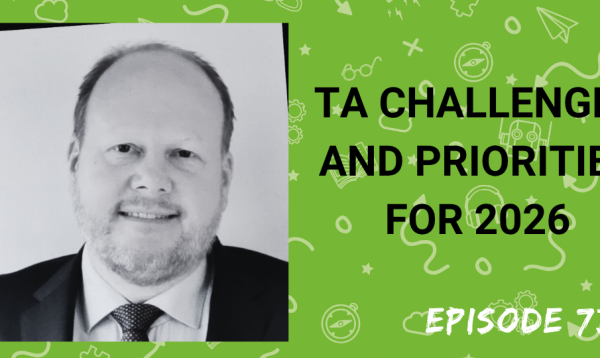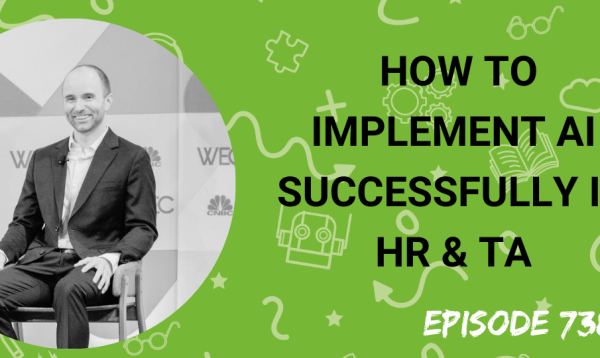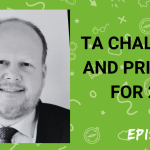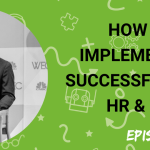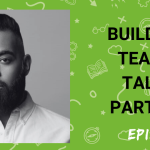Back in 2008, I read a book about emerging social technologies that had a massive influence on the direction of my career. That book was called Groundswell, and I’m delighted that one of its authors is my guest this week. Charlene Li is now the bestselling author of six books, an analyst, entrepreneur, advisor, and investor. She is also one of the preeminent experts on the topic of digital transformation.
Charlene’s new book is called The Disruption Mindset, and in our conversation, we discuss the talent strategies and thinking required for digital transformation.
In the interview, we discuss:
- How things have changed and developed in the decade since Groundswell
- The disruption mindset, what it is and why it is important
- The importance of people and culture in digital transformation
- What makes a disruptive leader and how do you build a disruptive team
- Why digitization of the workplace is the most significant opportunity for radical change
Charlene also shares some examples of companies who are fully considering people issues in their digital transformation strategies.
Subscribe to this podcast in Apple Podcasts
Transcript:
Matt Alder [00:00:00]:
Support for this podcast comes from ClickIQ. ClickIQ is an automated job advertising platform that uses the latest AI and programmatic technology to manage, track and optimize the performance of your recruitment. Advertising in real time spend is focused where it’s needed the most to reach both active and passive job seekers across indeed, Google, Facebook and an extensive network of job boards. To find out more about ClickIQ, please visit www.clickiq.co.uk. that’s www.clickiq.co.UK.
Matt Alder [00:01:01]:
This is Matt Alder. Welcome to episode 190 of the Recruiting Future podcast. Back in 2008 I read a book about emerging social technologies that had a massive influence on the direction of my career. That book was called Groundswell and I’m delighted that one of its authors is my guest this week. Charlene Li is now the best selling author of six books, an analyst, an entrepreneur, an advisor and an investor. She’s also one of the preeminent experts on the topic of digital transformation. Charlene’s new book is called the Disruptive Mindset and in our conversation we discuss the talent, strategies and thinking required for digital disruption and digital transformation. Enjoy the interview. Hi Charlene and welcome to the podcast.
Charlene Li [00:01:53]:
Thank you for having me on it.
Matt Alder [00:01:54]:
An absolute pleasure to have you on the show. For the people who may not know you, could you just introduce yourself and tell us what you do?
Charlene Li [00:02:02]:
Sure. I am a author and analyst, so I’ve written a ton of books around how technologies are impacting strategy and business and I’ve been a longtime analyst. I’m now a senior fellow at Altimeter, which is a profit company and which I founded in 2008, was acquired by Profit in 2015.
Matt Alder [00:02:18]:
Fantastic. Now, going back to Roundabout 2008, you co authored a book called Groundswell about social technologies, which was, which is actually a real inspiration to me at the time when I was, when I was reading it and looking at how business was changing and might change in the future, can you sort of tell us a bit about your perspective of the journey that we’ve been on over the last decade when it comes to social technologies and digital transformation?
Charlene Li [00:02:45]:
Sure thing. Back in 2008 when I wrote the book, people really thought that social was going to be a fad. They weren’t quite sure if it was going to stick around. If did they need to take it seriously and what Josh Bernoff, my co author and I really want to lay out was, yes, take this very seriously. It is going to change so many of the things in the way that we work, but more importantly, how we communicate and establish relationships. And then I think over the past decade, we have seen that happen. We now connect with people we could never before. And there are some great things that come out of that, but also some problems that come out of it, as we have seen. So I think it’s still evolving as we see companies like Facebook, Google, even Amazon trying to grapple with what these new technologies are going to mean in terms of our relationships.
Matt Alder [00:03:35]:
Absolutely. I mean, I couldn’t agree with that more. So you’re just about to publish a new book called the Disruption Mindset. Why did you write that book and what’s it about?
Charlene Li [00:03:45]:
Well, for the longest time, I’ve said as my purpose is to help leaders thrive with disruption. And people started asking me, so how do I actually do that? How do I thrive with this? How do I put together a disruption strategy? And I realized I didn’t have a satisfactory answer. And so when I come across something that I need to know more about, I do research. And then sometimes it ends up being a book. And that’s what happened here. And what I really wanted to figure out was what was the answer? How do you actually disrupt yourself? Because a lot of the conventional wisdom out there is that as an incumbent, as an established organization, it could be a hundred people or 100,000 people. You can’t disrupt yourself because you’re so in love with your current profits and the current business model. It’s really hard to change that. And what I was seeing was so many other companies and examples where people were actually doing this. So I set up to say, how are they doing this? How are they able to do go through not just a digital transformation, but a disruptive transformation, and in the process create exponential change and growth.
Matt Alder [00:04:51]:
So I suppose to dig into that last bit, just to kind of give a bit of context, when you say disruption, what do you mean by it and why is it so important right now?
Charlene Li [00:05:03]:
Well, I think disruption happens when your status quo is upended, and that could be because of technology. But more importantly, disruption feels painful, feels uncomfortable, because there’s some shift in power in the relationships either in your organization, with your customers, or throughout your ecosystem in your industry. So how do you recognize it? And then how do you harness that so that the opportunities created by that disruption are in your favor versus against you? So when I see people saying, oh, yeah, I feel like I’m being disrupted by X and it could be any number of things. It could be even just a simple thing. In the context of your podcast here about these millennials coming to work. They’re a disruptive force just because of the generational change that they represent in an organization. How do I deal with that? How do I think about that? I came up with a model that says this is how you can think about disruption and how do you make it work for you?
Matt Alder [00:06:01]:
Tell us a little bit more about the model that we can find in the book. How can we all be more disrupt?
Charlene Li [00:06:07]:
Sure. So I look at three aspects of disruption, the strategy, the leadership, and then the culture. And the strategy is simply this, that to figure out what you should be doing and not be doing, you need to focus on your future customers. We all know we want to be customer centric, customer first. But oftentimes we’re looking and focusing too much on today’s customers versus trying to figure out where our customers are going to be in the future. What I found from the research is that the organizations that are best able to create disruption, in other words, to turn their back on their current customers, have a really clear idea of where they’re heading. They spend an inordinate amount of time focusing on what do future customers need and want and then creating resources and opportunities today to create that future, to make that future happen. It’s a simple idea, but incredibly difficult to do.
Matt Alder [00:07:03]:
Yeah, I mean, absolutely. And I suppose the interesting parallel for me from a, from a people and talent perspective is companies having to look for different types of talent for their organizations and think in a very, very different way and disrupt the way that they sort of recruit and bring people into the organi. Into the organization.
Charlene Li [00:07:25]:
Yes, absolutely. And you know that you need your strategy and the people and the culture, everything to line up against each other. So if you’re trying to focus on the people of today, the people, the strategy of today, the customers. Today you’re going to hire for a certain type of type of people, but if you focus on a different type of customer, that’s going to require different skills, the way you recruit, the way you hire is going to be completely different. And you, even those, those people may be incredibly difficult to find. You’re going to put a big investment into that, knowing that you’re preparing for that future.
Matt Alder [00:07:58]:
Absolutely. I suppose the thing that’s interesting to me is that there’s a huge amount that’s written and spoken about when it comes to digital transformation, you know, digital disruption. And obviously, as you sort of suggested, lots of companies are trying this, but it always seems like the talent aspect of it actually having the people in the business to do it is something that doesn’t get discussed as much. And companies don’t necessarily put as much focus on as they do to say the strategy part of the change. Why do you think that is and how could it be changed?
Charlene Li [00:08:36]:
Well, I think they put too much emphasis on the digital and not enough on the transformation part of digital transformation. And my colleagues at Altimeter and I have been focused on the people aspect of digital transformation right from the very beginning. Because what we find the reasons why digital transformation does not work in an organization isn’t because they don’t have the right technologies, is because people aren’t adopting it. They don’t have the right people. The process they changing the way that people work, that’s the transformation part. And they usually don’t prepare enough on the people and culture side and even the strategy side. I’ll give you an example. I talked to one organization that wanted to do a transformation of the employee experience. They knew it was backwards, it was antiquated. So they went through a whole digital transformation and put in lots of platforms and everything. In the end, what they had was a beautiful platform that could streamline the way HR gets done all the transactions and everything. But they hadn’t moved the needle forward in terms of really addressing what kind of experience, what kind of relationship do I want with my employees? How do I rethink the way that people want to work and connect with my employers today? That’s they weren’t taking into account that people wanted to work in different ways remotely flexible time. How do we build diversity and inclusion into the way that we create a relationship with people? So they kind of took the today’s transactions and modernized them and made them digital, but they didn’t go through the transformation part.
Matt Alder [00:10:12]:
Why do you think that is? Why do you think companies miss that part of this?
Charlene Li [00:10:16]:
I think more anything else because they focus so much on the digital. And again, this is the way that we’re kind of wired. We’re kind of wired to look at what’s happening today versus saying do we have the permission and the audacity to think about a different future? Because that requires a lot of permission, a lot of agency, a lot of thinking out of the box. And that’s not the way that most organizations are built today. And what I found with the disruptive organizations, they’re built in a very different way. They’re organized and their leadership, their culture is wired in A completely different way to allow that kind of thinking.
Matt Alder [00:10:56]:
I was going to say, from the sort of the work and the research that you do, could you sort of give us some examples of that type of company? Who is it that’s getting this right?
Charlene Li [00:11:08]:
I’ll give a couple examples. So one is ING bank in the Netherlands. What they did is they realized that they were not serving their the financial services business, banking very well. And they could see all the fintech companies coming up. So they said we got to get rid of all this bloated bureaucracy, cut costs, but not just cut costs, but take those savings and invest them back into a better customer experience. And they realized that they were not set up structurally to be able to move at the speed of their fast changing customers. They literally blew up their headquarters, turned it completely into agile, rehired everybody back into the organization, went to a stadium one day, said old ING doesn’t exist anymore, this is the new. And they went back to new offices completely agile team based because they realized cross functional teams were going to be the right way to be able to move fast. This couldn’t be a department by department agile transformation. They had to change everything up. So they took a very people and customer centric view of how they were going to go through a digital transformation. The other one was Adobe. So they went from package software to subscription software with Creative Suite to creative Cloud. And they knew that this would change everything. So instead of buying a box of software, you would now subscribe to it, a monthly subscription. And you can imagine sales is completely different. The way you build your website, the way you do accounting, the way you do customer service. No customer was asking for this, but they knew it would create a better experience for their customers in the future. Nobody internally wanted to do this because it was going to be a huge change for their jobs. And then they’re a publicly traded company and they knew that the revenues in income would go down for the next 24 months. And yet they did this. And it was an extraordinary example of leadership. I think what I call leadership is creating a movement for a new change. The leadership just didn’t blink. That executive team just said, this is absolutely the right thing. So quarter after quarter, the CFO went in front of Wall street and said, I’ve got great news for you. Our revenues and our income are down. Our plan is working. Isn’t that great? And the stock price would go up. I’ve never seen anything like this.
Matt Alder [00:13:34]:
Fantastic. And that’s kind of a huge amount of vision and bravery to do that. And and to do that successfully.
Charlene Li [00:13:40]:
And so I think in many ways the things that Adobe and IAG bank did is they looked at the strategy future. They think about the leadership that’s needed. They created movements inside of the organization because they realized to actuate that strategy, it was going to be incredibly difficult, incredibly hard. And you don’t lead in a regular way and you don’t have an everyday type of leadership. You have to have a very disruptive type of leadership. And for your audience, there’s one bit of information that I thought was fascinating. I did a survey of leaders of a thousand leaders around the world and in the US I was asking about their leadership ability to be disruptive, and it came down to two factors. One is, are you open to change? And do you, as your leadership style, really empower and inspire people to take on the mantle of leadership, to take action themselves? What I found is that women, especially in the US could have the same level of ability for leadership and the same mindset for openness, yet saw themselves as significantly different level below in terms of their perception of themselves as being disruptive. And that has a huge implication for how we develop leaders. Because if we want to create a disruptive organization with leaders capable of creating movements, if they themselves as a group, as a gender class, women don’t see themselves as disruptive and capable of driving that, then we’re losing a lot of opportunity. So I think that’s a huge issue to say, how do we develop disruptive leaders in our organization so they can take on this type of exponential change.
Matt Alder [00:15:24]:
Absolutely. And that leads on really to the next question that I was going to ask you, which is, as individuals, how can we be more disruptive? What would your advice be to someone who’s wanting to be more disruptive in their kind of approach to life and to work?
Charlene Li [00:15:42]:
Sure, yeah. I think there’s a desire and then innate. So you can change your mindset, you can change your leadership behaviors, but that changes gradually. So I have four different archetypes, and I’ll take one in particular that I think a lot of people fall into so that. So if a really good disruptive person is what I call a realist optimist, this person has a really strong openness mindset, but also is paired with these incredible abilities to lead through other people to actuate that change. The other group, though, may not be as just naturally open. They tend to see the glass as half empty, and they’re really good at cleaning up all the messes that some of the more disruptive people may be creating, but I call them the worried skeptics. They’re the ones who are like but what happens if we do that? They’re conservative. They’re the ones who make sure things happen. What you want to do is pair. If you’re a worried skeptic, you want to find some other the archetypes to partner with. Even the realist optimists, there aren’t enough of them inside an organization that they need to partner with some of the other archetypes. So being able to understand who is what type of disruptive leader and making sure you support their strengths and being able to tap into that and make sure you’re working together as a team because you can walk around and you know who the disruptive. I put in quotes people are in your working together. And some of them are really effective leaders. Some of them, I call them the agent provocateurs because they’re really disruptive but they don’t quite have the leadership capabilities to make that change happen. You pair them with somebody who I call a steadfast manager who really knows how to get things done but may not be as change oriented and that becomes an incredible power couple. So that’s some ways to be thinking about how do you expose yourself to the people who have the skills that you want to have so you can start developing yourself as a disruptive leader.
Matt Alder [00:17:45]:
So we started off the interview talking about what had happened over the last ten years or so. What’s your view on how this is all going to develop over the, over the next decade? Where do you think we’re going and how quickly are we going to get there?
Charlene Li [00:17:59]:
Well, I put a huge focus on HR in particular as a function because I think it’s one of the most important areas for a digital transformation. And yet HR doesn’t see themselves sitting at the strategy table. They see themselves as the people who execute the programs versus being at the table trying to drive where that program goes. So I think one of the biggest changes we’ll see, we’ve seen so many changes happening on the consumer side, but organizations kind of run the same way as they did 10 years ago. So I think the biggest change and potential for just radical ways of changing the way we work is the digitalization of the work process. So if you think about how we collaborate, how we communicate, it’s a lot through email. Still, despite all these fantastic collaboration platforms, we just beginning to touch onto how we could really change our organizations, our process, our and what I call our lore L O R E All the stories and rituals and symbols that we have. Because I think in many ways the biggest barrier to digital transformation, to us having better work lives, is culture. And yet we think that we can’t change culture. We can’t move and turn the battleship because the levers to do that are so difficult. But I think in a digital world where you are able to understand how you can change these things, you can actually create change very, very quickly. But you have to know which levers to pull and put those in place.
Matt Alder [00:19:34]:
Absolutely. So final question. Where can people find you and where can they find the book?
Charlene Li [00:19:40]:
Sure, they can find me and at my website, charlene li.com c h a r l e n e l I.com and you can find the book there. And you can find me on LinkedIn, Twitter, pretty much every single place you can, you can find me with that, that, that name. Charlene Li.
Matt Alder [00:19:58]:
Charlene, thank you very much for talking to me. My thanks to Charlene Li. You can subscribe to this podcast in Apple Podcasts or via your podcasting app of choice. The show also has its own dedicated app, which you can find by searching for Recruiting Future in your App Store. If you’re a Spotify user, you can also find the show there. You can find all the past episodes@www.rfpodcast.com. on that site, you can subscribe to the mailing list and find out more about working with me. Thanks very much for listening. I’ll be back next week and I hope you’ll join me.


